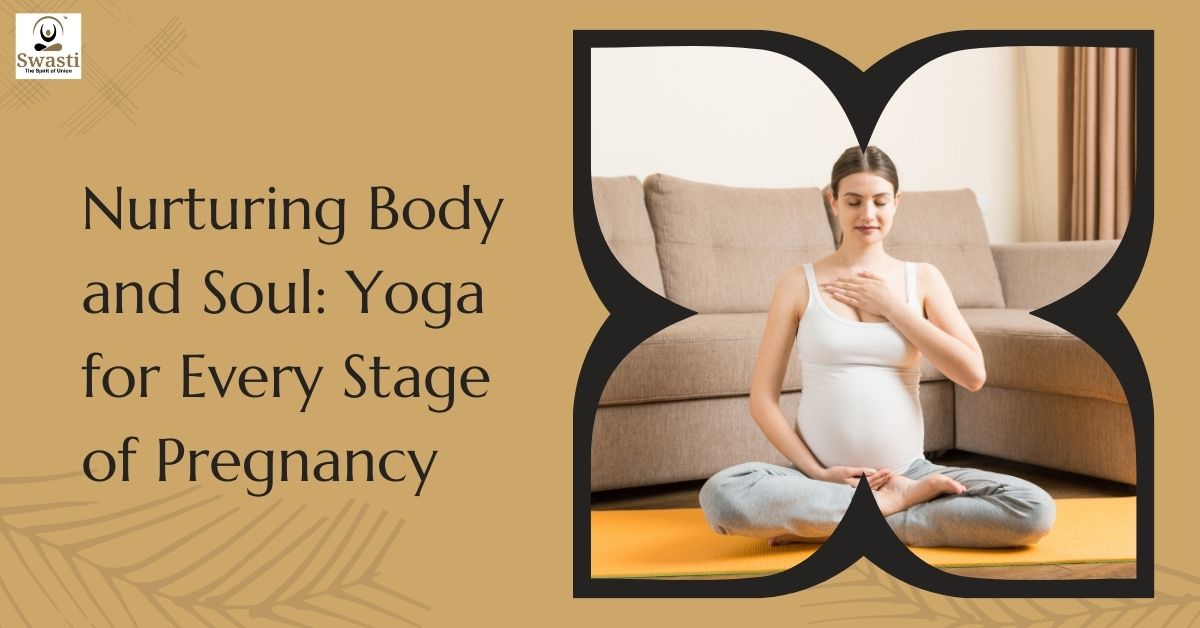Pregnancy is a miraculous journey that brings about profound changes in a woman’s body and soul. It is a time of immense transformation, both physically and emotionally, as a new life grows within. During this special time, it is essential to take care of not just the physical body but also the soul, nurturing both with love and mindfulness. One powerful way to achieve this balance is through the practice of yoga, which offers a multitude of benefits for expectant mothers at every stage of pregnancy.
Yoga is an ancient practice that combines physical postures, breathing techniques, meditation, and relaxation to promote overall well-being. When adapted for pregnancy, yoga becomes a gentle yet effective tool for staying healthy, reducing stress, connecting with the baby, and preparing for childbirth.
First Trimester: Building a Foundation
During the first trimester of pregnancy, the body undergoes significant changes as it adapts to the presence of new life. This period is crucial for laying a strong foundation to support the growing baby and prepare for the months ahead. Incorporating gentle yoga poses that focus on alignment, breathing, and relaxation can be highly beneficial in alleviating common discomforts such as nausea, fatigue, and mood swings.
Which are Suitable Yoga Poses in the First Trimester?
- Cat-Cow Stretch: This dynamic yoga pose involves moving between arcing and rounding the back while coordinating with breath. It helps to gently stretch and strengthen the spine, improving flexibility and relieving tension in the back muscles. The rhythmic movement also aids in promoting circulation and enhancing spinal alignment.
- Child’s Pose (Balasana): This resting pose is excellent for releasing tension in the lower back, hips, and thighs. By folding forward with arms extended or resting by the sides, it provides a gentle stretch to the back muscles while promoting relaxation and calming the mind. Child’s Pose can help alleviate fatigue and create a sense of comfort during moments of rest.
- Gentle Seated Twists: Seated twists are beneficial for stretching and toning the muscles along the spine, particularly in the mid-back region. Twisting movements help improve spinal mobility, stimulate digestion, and release tension in the hips and lower back. Gentle twists can also aid in reducing discomfort associated with bloating and gas during early pregnancy.
By incorporating these yoga poses into your first-trimester routine, you can effectively support your physical and emotional well-being during this transformative time. The Cat-Cow stretch, Child’s Pose, and Gentle Seated Twists not only help in strengthening the back, hips, and pelvic floor muscles but also promote relaxation and stress relief essential for maintaining emotional balance amidst the changes your body is experiencing. Remember to listen to your body’s cues, modify poses as needed, and consult with a prenatal yoga instructor or healthcare provider to ensure a safe and tailored practice for your unique pregnancy journey.
You may like to Read: 10 Best Prenatal Yoga Poses And Lifestyle Tips For Pregnant Women
Second Trimester: Embracing Change
As you progress from the first trimester into the second trimester of pregnancy, your body begins to embrace the changes brought forth by the growth of your little one. Known as the “honeymoon phase,” this period is characterised by increased energy levels and vitality, providing an opportune moment to deepen your yoga practice and explore more advanced poses.
Which are Suitable Yoga Poses in the Second Trimester?
- Warrior II (Virabhadrasana II): This standing pose promotes balance, stability, and strength in the legs, core, and pelvis. Warrior II encourages proper alignment and improves postural awareness, all of which are important factors in supporting the weight gain and shifting center of gravity that occur during pregnancy. Additionally, this pose helps open up the chest and shoulders, encouraging deep breathing and relaxation.
- Tree Pose (Vrksasana): A balancing pose that challenges stability and concentration, Tree Pose helps develop mental focus and calmness. Practicing Tree Pose during the second trimester can assist in improving proprioception – the body’s awareness of its own position and motion – which is critical for maintaining balance during pregnancy. Furthermore, this pose strengthens the leg muscles, especially the quadriceps and hip flexors, helping to counteract the strain placed upon them due to the added weight of the uterus.
- Pigeon Pose (Eka Pada Rajakapotasana): An intense hip-opener, Pigeon Pose releases tightness in the gluteal muscles, piriformis, and surrounding areas. This pose helps maintain flexibility in the hips and pelvis, which is necessary for comfortable sitting and walking during pregnancy. Moreover, Pigeon Pose can alleviate sciatica symptoms and other lower back issues commonly encountered during this stage.
Exploring more challenging poses during the second trimester allows you to build strength, flexibility, and balance, all of which will serve you well during the final weeks of pregnancy and beyond. However, remember to always prioritize safety and listen to your body’s signals. Modify poses as needed, avoid overstretching, and seek guidance from a qualified prenatal yoga teacher if unsure about specific poses or modifications.
Third Trimester: Surrendering with Grace
As you enter the third trimester of pregnancy, a time of surrender and preparation for childbirth and motherhood unfolds. This stage is marked by significant physical changes as your body readies itself for the birthing process. It becomes crucial to honor your body’s needs during this period and approach your yoga practice with gentleness, compassion, and a sense of surrender.
Which are Suitable Yoga Poses in the Third Trimester?
- Supported Bridge Pose (Setu Bandhasana): This restorative pose gently opens the chest, hips, and pelvis while providing support to the lower back. Supported Bridge Pose helps alleviate back pain, promote relaxation, and improve circulation in the pelvic region. By elevating the hips with props like bolsters or pillows, this pose encourages a sense of grounding and stability, fostering a connection with the earth beneath you.
- Legs-Up-the-Wall Pose (Viparita Karani): A soothing inversion pose that allows for gentle stretching of the legs and lower back while promoting relaxation and reducing swelling in the feet and ankles. Legs-Up-the-Wall Pose encourages blood flow back to the heart and can help alleviate discomfort associated with fluid retention common in late pregnancy. This pose also offers a calming effect on the nervous system, aiding in stress reduction and better sleep quality.
- Reclining Bound Angle Pose (Supta Baddha Konasana): This restorative hip-opening pose supports pelvic floor relaxation and optimal fetal positioning. Reclining Bound Angle Pose helps release tension in the inner thighs, groin, and pelvis while promoting a sense of surrender and openness. By gently opening the hips and pelvis, this pose prepares the body for childbirth by encouraging flexibility and ease in movement during labor.
These poses focus on relaxation, circulation enhancement, pelvic opening, and surrendering control – all essential aspects as you prepare for the transformative experience of childbirth. Remember to approach your practice with mindfulness, adapt poses to suit your comfort level, and embrace the natural process of birth with grace, trust, and self-compassion. Consult with a prenatal yoga instructor or healthcare provider for guidance on safe modifications tailored to your individual needs during this stage of pregnancy.
Benefits of Prenatal Yoga
- Physical Benefits: Yoga helps improve strength, flexibility, balance, posture, circulation, digestion, and immunity during pregnancy.
- Emotional Benefits: Yoga reduces stress, anxiety, depression while promoting relaxation, mindfulness, self-awareness, gratitude.
- Spiritual Benefits: Yoga fosters connection with the baby, inner wisdom, intuition while deepening trust in the body’s ability to give birth.
- Preparation for Childbirth: Yoga teaches breathing techniques (pranayama), visualization exercises (bhavana), labor positions (asanas) that can aid in a smoother birth experience.
- Postpartum Recovery: Yoga helps in faster healing post-birth by strengthening core muscles (transverse abdominis), pelvic floor muscles (mula bandha), promoting relaxation (savasana).
Conclusion –
In conclusion, incorporating prenatal yoga into each stage of pregnancy – from building a foundation in the first trimester, embracing change in the second trimester, to surrendering with grace in the third trimester – can nurture both body and soul, preparing you for the miraculous journey of motherhood. For expert guidance and support in your pregnancy yoga journey, consider exploring Pregnancy yoga TTC in Pune to experience the benefits firsthand.


